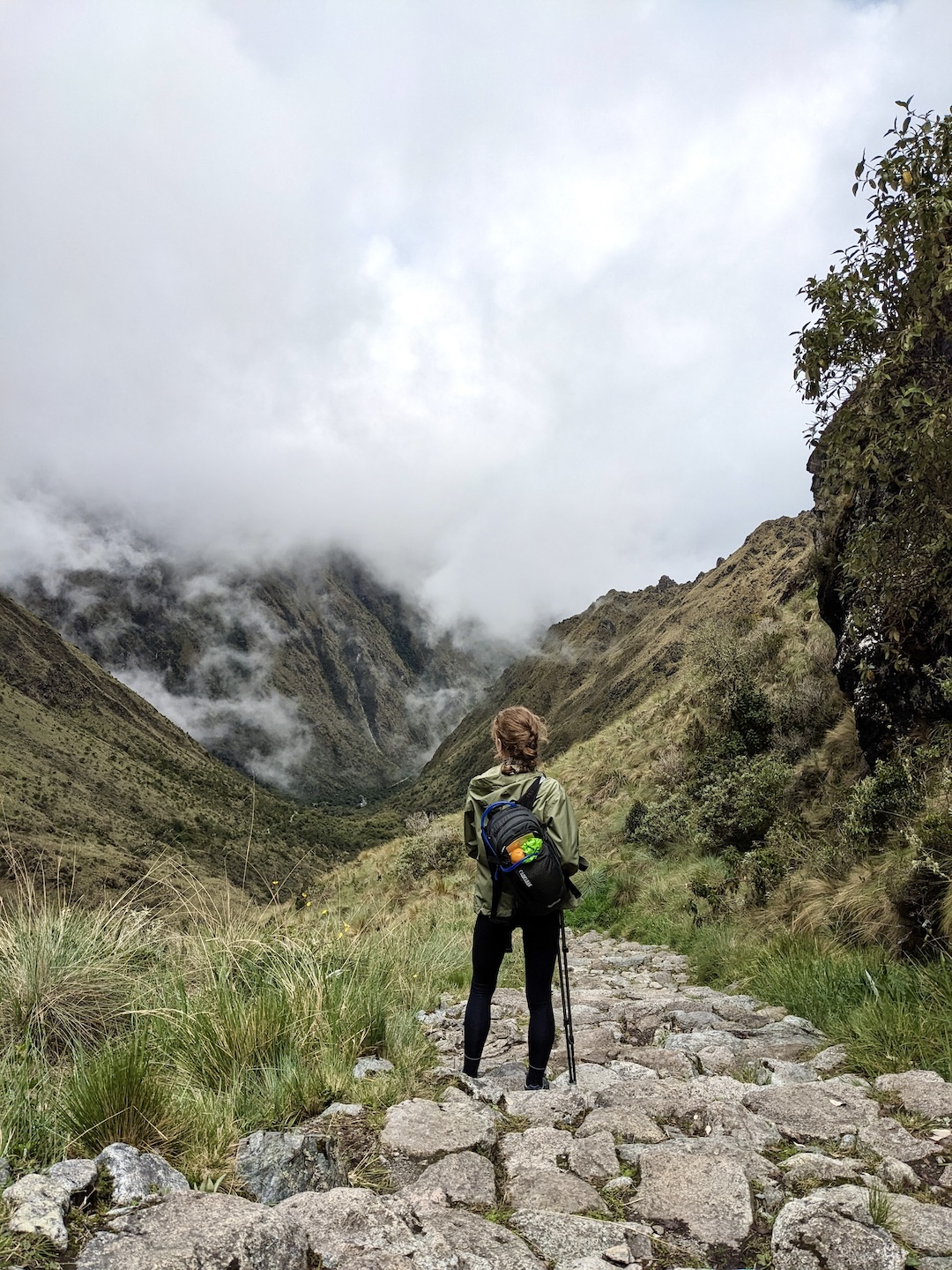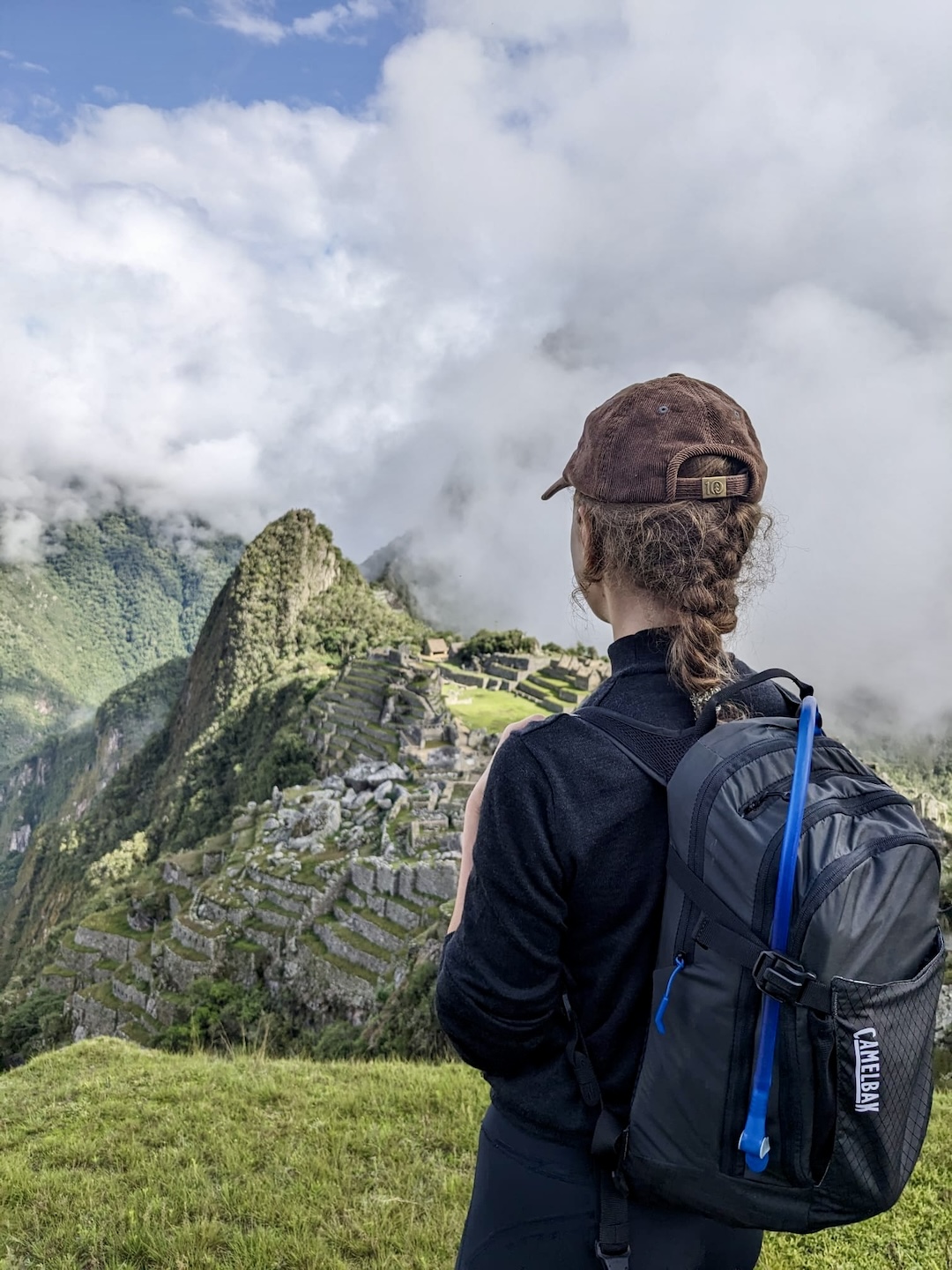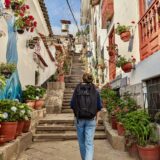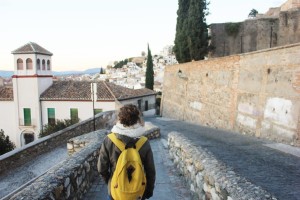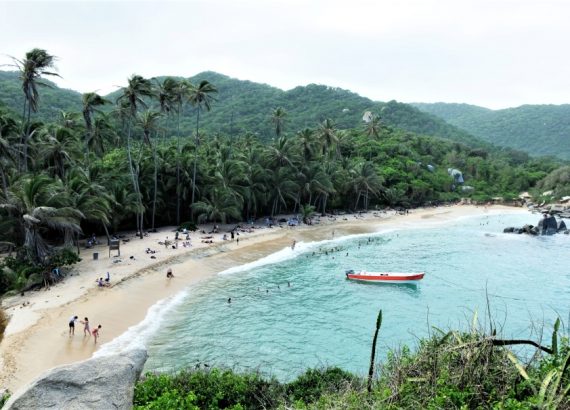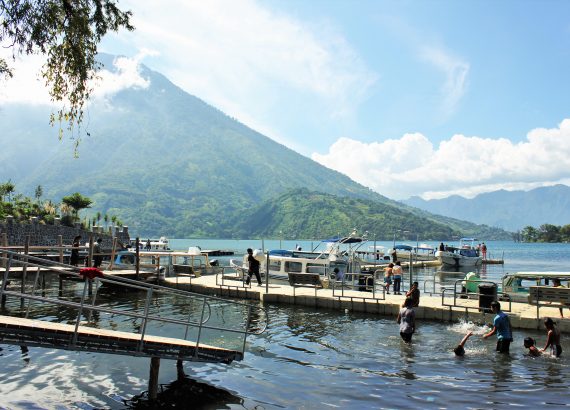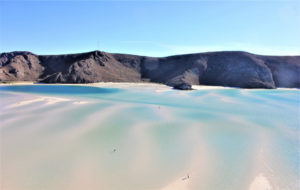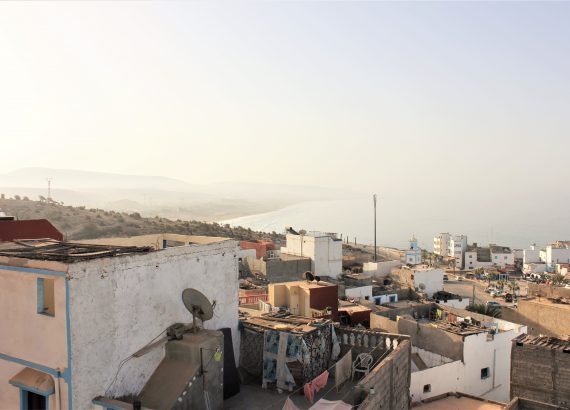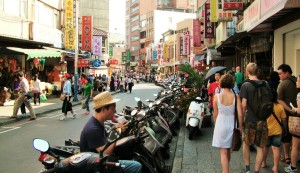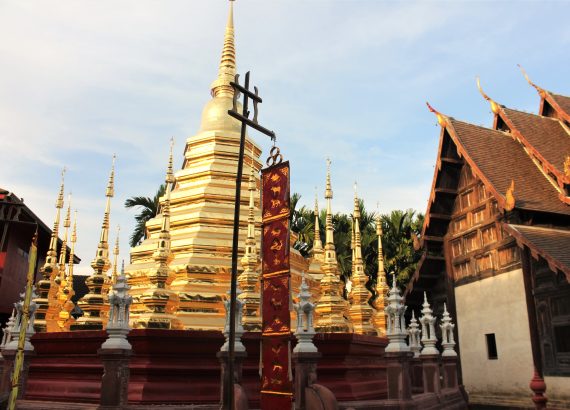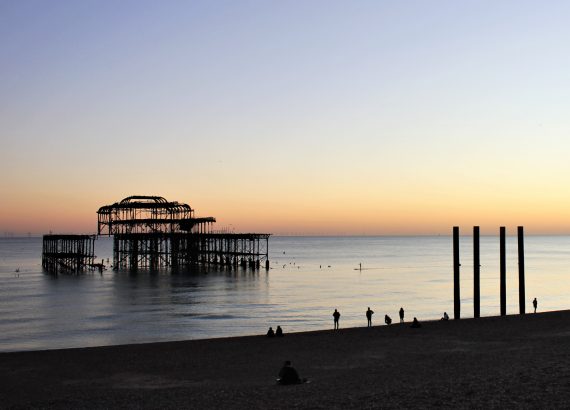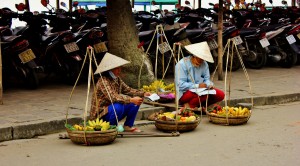Hiking the Inca Trail to Machu Picchu
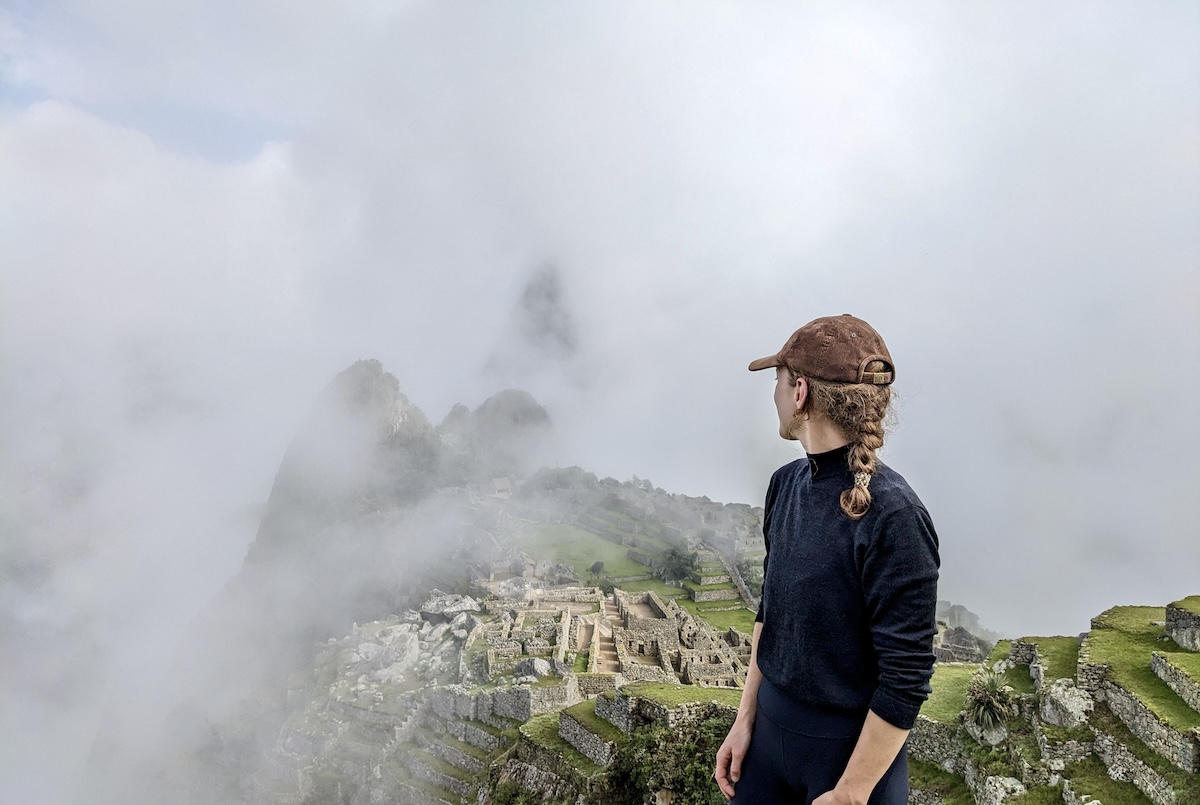
Hiking the Inca Trail is a dream come true for many an intrepid traveller. This wanderlust-inducing trail through the Peruvian Andes takes you along ancient stone paths, high into the mountains and down through cloud forests.
The Inca Trail trek ends at the magnificent Machu Picchu, one of the seven new wonders of the world. It is the most iconic multi-day hike in South America, if not the world.
After completing the 4-day, 3-night Inca Trail hike, we’ve made fastidious notes on how to ensure you have a successful hike and distilled them into this handy Inca Trail hiking guide. We wish we’d known a few of these things before our trek — like just how fit you need to be, how much rain gear to bring, and that there isn’t fresh coffee (only instant).
What is the Inca Trail?
The Inca Trail is a 4-day, 3-night hike starting at Km 82. The hike’s starting point is 40 minutes outside the town of Ollantaytambo. The hike ends at Machu Picchu and this is the only route that passes through the Sun Gate (Inti Punku).
The total length of the hike is 43km (26 miles). It’s a short-ish hike you might be thinking. Whilst the distance isn’t wild, the tough part of the hike is the altitude and narrow, undulating Incan stone steps that are an effort to climb up and hard on the knees when coming down.
Is the Inca Trail Trek Right For You?
The Inca Trail trek is right for you if:
- The idea of walking in the steps of the Incas excites you
- You love hiking and don’t mind walking in any weather conditions
- You enjoy a challenge
- You have 4 days available
- You don’t mind camping in basic conditions
How Difficult is the Inca Trail?
For regular hikers or those with a generally good fitness level, the Inca Trail trek is moderate difficulty. The second day of the hike is widely considered to be the most challenging with an uphill hike to Dead Woman’s Pass, the highest point of the trail at 4,200m. This is followed by a steep downhill on Incan stone steps that is challenging for the knees.
The Inca Trail is not as wildly challenging as you may think, but it is hard work. We found the trail to be less challenging than expected. Whilst we didn’t suffer altitude sickness, Luke unfortunately struggled on day one after throwing up from drinking some roadside ‘chica‘ — a local, fermented corn drink (maybe don’t drink that). We took Dead Woman’s Pass slow and steady and were fine. We found the downhill harder due to pouring rain that made the steps slippery.
Parts of the trail were hard on the knees, and honestly it’s worth having hiking poles to make this stretches easier. The second half of day two and majority of day three are downhill on smooth and chunk stone steps. Overall though, we found the hike satisfying and enjoyed taking the long route to Machu Picchu.
It’s worth noting that we spent two weeks acclimatising and hiking in the Sacred Valley (a luxury we know!) before hiking the Inca Trail. This let us have plenty of time to get used to the altitude and the types of terrain.
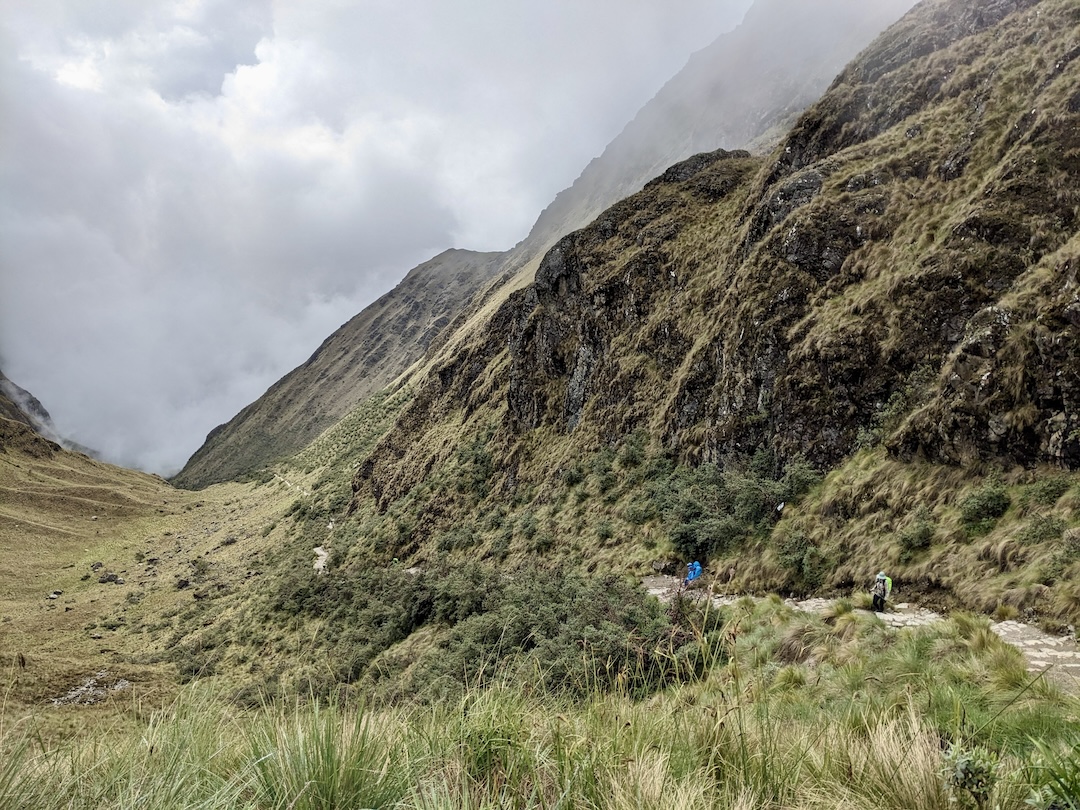
Are There Other Ways to See Machu Picchu?
You don’t have to spend 4 days hiking the Inca Trail to see Machu Picchu, though it is perhaps the most rewarding way to get there. You can visit Machu Picchu without hiking by taking the train to Aquas Calientes, the gateway town to Machu Picchu. From there, take a bus up to the entrance gate. Machu Picchu tickets need to be reserved in advance as it can get very busy.
There are also other hikes such as the 2-day version of the Inca Trail and the 5-day Salkantay trek that end at Machu Picchu.
Alternative Options from the Inca Trail
- Train from Ollantaytambo — If hiking is not your jam, take a train from Ollantaytambo to Aquas Calientes and change for a bus directly to the gate of Machu Picchu. Trains used to run from Cusco but as of January 2024 the line is still under repair and instead the train company will transport you by mini bus to Ollantaytambo. The journey from Cusco is 4 hours one-way, so it’s recommend to stay the night in either Ollantaytambo or Aquas Calientes. Both are quite touristy, as you would expect for the towns closest to Machu Picchu.
- 2D/1N Inca Trail — If you are keen to hike but are not a confident hiker, the 2-day Inca Trail is a fantastic option. This route follows the Inca’s commercial route and is only one day of hiking. The first day of the hike starts off the same as the classic Inca Trail. There are some beautiful Incan ruins that can’t be seen if you’re not hiking. There’s an option to camp or stay in a hotel overnight. The second day is touring Machu Picchu itself.
- 5D/4N Classic Inca Trail — Some tour operators also offer the same 4D/3N classic Inca Trail trek over an additional day. This trek suits hikers who feel strongly about walking the Inca Trail path but would like to walk a shorter distance each day. It’s worth bearing in mind that as campsites and facilities are basic on this trek, it does mean an extra day and night away from ‘home comforts.’
- 5D/4N Salkantay Trek — If you’re a confident hiker but prefer a lodge with a hot shower at the end of your hiking days, then the Salkantay is for you. This trek is considered to be slightly easier than the Inca Trail, though still challenging. We hiked the Salkantay Pass and it was a challenging ascent to 4,600m! After this, it’s downhill towards Machu Picchu for the following days. The main benefit of this trail is staying in lodges each evening instead of camping — a particularly good option if you’re hiking in the rainy season.
Booking the Inca Trail Hike
What is the Best Time of Year to Hike the Inca Trail?
Peru has two seasons: the dry season (May-October) and the wet season (November-March).
The best time to visit Machu Picchu and hike the Inca Trail is often said to be from late March to May and from September to early November. These months fall within the shoulder seasons where it’s not too hot but also unlikely to rain, therefore giving the best weather conditions for hiking and visibility at Machu Picchu.
The dry season from June to August is often crowded. More tourists travel in these months due to summer holidays in the USA, UK and other countries. The trails and campsites can be busy during this period. The hiking conditions can also be hard due to hot days with direct sun overhead.
We hiked in early December, which is during the rainy season. We were fairly lucky with the weather, having one sunny day, only a half-day of heavy rain and just light rain on other days. However, weather conditions are not always as favourable and if you do hike in rainy season, go into it knowing that it’s possible that there may be rain throughout the hike.
Our guide shared with us that he often tries to do fewer Inca Trail treks during the rainy season because many of the tourists who join the hike aren’t prepared for the reality of 4 days trekking in the rain. Unfortunately, he has had experiences of hikers being upset and angry with him about the weather conditions, despite these being out of his control (and his many prayers to Pachamama!)
Having experienced hiking part of the Inca Trail in heavy rain, it is unpleasant. By the time I reached the lunch point feeling very damp there was nothing I wanted to do less than go back out in the torrential rain for the next 4 hours of hiking. If you are the kind of person who will be miserable in this situation, then avoid the rainy season.
If you don’t mind a bit of weather variation, then you’ll likely be fine with the rainy season. The rain is rarely constant and often there are dry patches, plus you might be lucky with pleasant weather. The trail overall is greener and lusher during this season with more flora and fauna. This season also has fewer hikers, so the trail and campsites are less crowded.
The Inca Trail is closed in February. The closure is both in place for preservation of the Inca Trail and for safety to reduce accidents as February is the month with the heaviest rains. Machu Picchu remains open during February, but cannot be accessed via the Inca Trail.
How Do Inca Trail Permits Work?
You’ll need a permit to hike the Inca Trail, but fortunately your tour company will take care of organising this for you. Only 500 people are allowed on the Inca Trail per day (roughly 200 tourists and 300 accompanying guides and porters). The permits are essential to manage this footfall.
Securing a permit is only possible with an approved tour provider. There are only limited tour providers operating on the Inca Trail. This means that you have to do the Inca Trail with a tour company and, to be honest, we think this is for the best given the length and tricky conditions of the trek.
Once you book an Inca Trail trek through one of the approved tour companies, they will organise your permit and update you once it’s sorted. The dates on the permits cannot be changed which means you need to be 100% sure that you are committed to the trekking dates. You won’t be able to change or cancel your Inca Trail trek once your permit is organised.
Do You Need a Guide?
Yes, you must have a guide for the Inca Trail. All the tour operators permitted to offer Inca Trail treks include a guide (usually two) for your hike. These guides are brilliantly knowledgable and won’t only be making sure you don’t wander off in the wrong direction, but will be sharing fascinating stories about the history and culture of the Inca Trail.
What’s the Best Inca Trail Tour Company?
There are a limited number of tour companies which are able to offer the classic 3D/4N Inca Trail trek. The most popular include Alpaca Expeditions, G Adventures, Intrepid Travel and TreXperience.
The offerings between these tour operators are similar. It can be hard to differentiate between them as, essentially, all tours are walking the same route (albeit staying at slightly different campsites) and have similar equipment and price points.
We chose to go with Alpaca Expeditions who had the best reviews at the time (December 2023) and were slightly more reasonably priced. We also compared commitments to porter welfare and working conditions, and were happy that Alpaca was a good choice for this too.
How Much Does the Inca Trail Hike Cost?
We hiked the Inca Trail in December 2023 and paid $750 (USD) per person. We also rented a sleeping bag ($20), air mattress ($15) and hiking poles ($15). This included porters to carry our bags.
The Inca Trail prices vary per season, so expect higher rates during the high season (June-August) and lower rates outside of peak season. The Christmas period can be slightly more expensive due to higher demand at this time of year.
Double check whether the price includes porters, as cheaper offers often mean you will be carrying your own backpacks. Tipping is also expected on top of this (see ‘Tipping Guides, Chefs and Porters on the Inca Trail’).

Preparing for the Inca Trail
How Far in Advance Do You Need to Book the Inca Trail Hike?
It’s recommended to book the Inca Trail trek at least 2 months in advance.
Since the COVID-19 pandemic tourism in Peru still hasn’t fully recovered and it can be possible to book more last-minute than this. We wouldn’t recommend risking it, especially as the Inca Trail and visiting Machu Picchu will likely be the main event and highlight of your trip to Peru!
How Fit Do You Need You Be?
Tour operators do not have restrictions on fitness required to hike the Inca Trail. However, they recommend that you are comfortable walking long distances and have some experience of multi-day hikes or at least long day hikes. It is also not recommended for those who have heart or other serious health conditions, as the trail is strenuous.
What To Pack for the Inca Trail
The Inca Trail has six different microclimates which means packing for every type of weather. Our Inca Trail packing list is a comprehensive list of everything you need in your backpack. We wish we’d had this before our own hike!
How Much Luggage Can You Bring on the Inca Trail?
There are two options for the classic Inca Trail tour. The most common is where you have porters to carry your luggage. The other option is to carry all your own luggage.
For most hikes, there will be porters who will carry up to 7kg of your personal items in a separate duffel bag. This weight includes a sleeping bag and air matt which you can bring yourself or rent from the tour operator. These two items usually weigh 3.5kg, leaving you with 3.5kg for the rest of your items. Trust us, this is enough!
You will also need to carry a day pack. 20L is the max size you’ll want for the daypack. You need space for 2-3L of water in the pack. Luke and I both carried 12L Camelbak daypacks with 2L water reservoir and they were fantastic.
If you opt to carry your own luggage, be sure to pack light because you will also need to carry your tent, sleeping bag and air mattress.
What Do You Do With the Rest of Your Luggage?
You’re very likely going to have a backpack or suitcase that needs storing whilst you’re trekking. Most tour operators offer luggage storage included within your tour price. It’s also common for travellers to return to the hotel/hostel they stayed at prior to the hike. Many hotels will store luggage whilst you’re away. If you opt for either of these options, it’s not recommended to leave any valuables (like laptops etc) in your luggage.
We were travelling with some expensive tech (MacBooks etc) that we didn’t want to leave nor take on the Inca Trail. We instead booked an Airbnb in Cusco which we stayed at before and after the hike, and chose to book for the nights we were away as well. This is the more expensive option, but also the safest if you have valuables you’re concerned about.
What If You Get Sick Before the Inca Trail?
In our hiking group, we had two people who were unwell before the Inca Trail trek: one from food poisoning and the other from a cold-flu. Avoid eating in Cusco’s markets in the days before the Inca Trail. Stick to ‘safe’ and less greasy foods to avoid any chance of food poisoning or tummy upset (we recommend Qura in Cusco). Unfortunately someone on our hike didn’t follow this advice and was very ill on the first day. Don’t go hard for too much alcohol in the days before the trek either as alcohol can make altitude sickness worse. Plenty of time for Pisco sours after the trek!
If you are generally unwell, it will make the trek unpleasant and much more challenging. The facilities on the trek are basic. There are only toilets every few hours and the camp sites only have cold water (and not very desirable showering conditions). The Inca Trail is costly, so many hikers who become unwell ahead of time will persevere. However, do consider the health of the group you’re hiking with if you have something that may be contagious as you will be sharing meals and in close proximity to your group, and whether you will truly be able to enjoy the experience.
Where You Need to Be in Peru
You’ll need to be based in Cusco or in the Sacred Valley close to Ollantaytambo before starting the Inca Trail. All of the tour operators are based in Cusco. There is also a briefing on the night before your first day of the Inca Trail which will take place in Cusco.
The transportation picks you up and drops you off in Cusco. Most tour operators will also pick up and drop off at Ollantaytambo and close-by areas of the Sacred Valley. Staying in these areas means you get a little more sleep before the early morning pick-up on day 1 and you’ll be back earlier on day 4. If you’re returning to Cusco, you won’t get back until 8pm on the final day. It’s a very long day as the wake up time is 3AM on day 4!
There is an airport in Cusco with daily direct flights from Lima. Remember that you need to leave at least 2 days to acclimatise in Cusco before hiking.
Hiking the Inca Trail
Inca Trail Map and Route
There is only one route along the classic Inca Trail hike to Machu Picchu. However, the itinerary can vary between tour companies, as some hike more or less on certain days and stay at different campsites. Our outline below is based on our hiking itinerary with Alpaca Expeditions and gives an overview of what to expect:
Day 1: Travel from Cusco to Km 82 and hike to the first campsite. You’ll pass through small villages with street vendors along the way for drinks, snacks and ice creams.
Distance: 14km
Difficulty: Moderate, but mostly due to acclimatisation.
Day 2: Early morning start up through the cloud forest. Up to Dead Woman’s Pass, the highest point at 4200m, then down many steps.
Distance: 16km
Difficulty: Challenging. This is the longest day of hiking. After Dead Woman’s Pass, the route is downhill but this is tough on the knees.
Day 3: Hike out of the cloud forests and into warmer climes. Plenty of smaller Incan ruins along the way. Do not miss the stunning Wiñay Wayna ruins which are optional to see at the end of the third day.
Distance: 10km
Difficulty: Fairly easy but with significant descents that are tough on the knees.
Day 4: Extremely early wake-up at 3AM. Followed by a 1.5 hour wait at the entry check-point (yawn) and 1-2 hours hiking to the sun gate and Machu Picchu.
Distance: 5km
Difficulty: The shortest and easiest hiking. You’re carried along by the elation of reaching Machu Picchu.
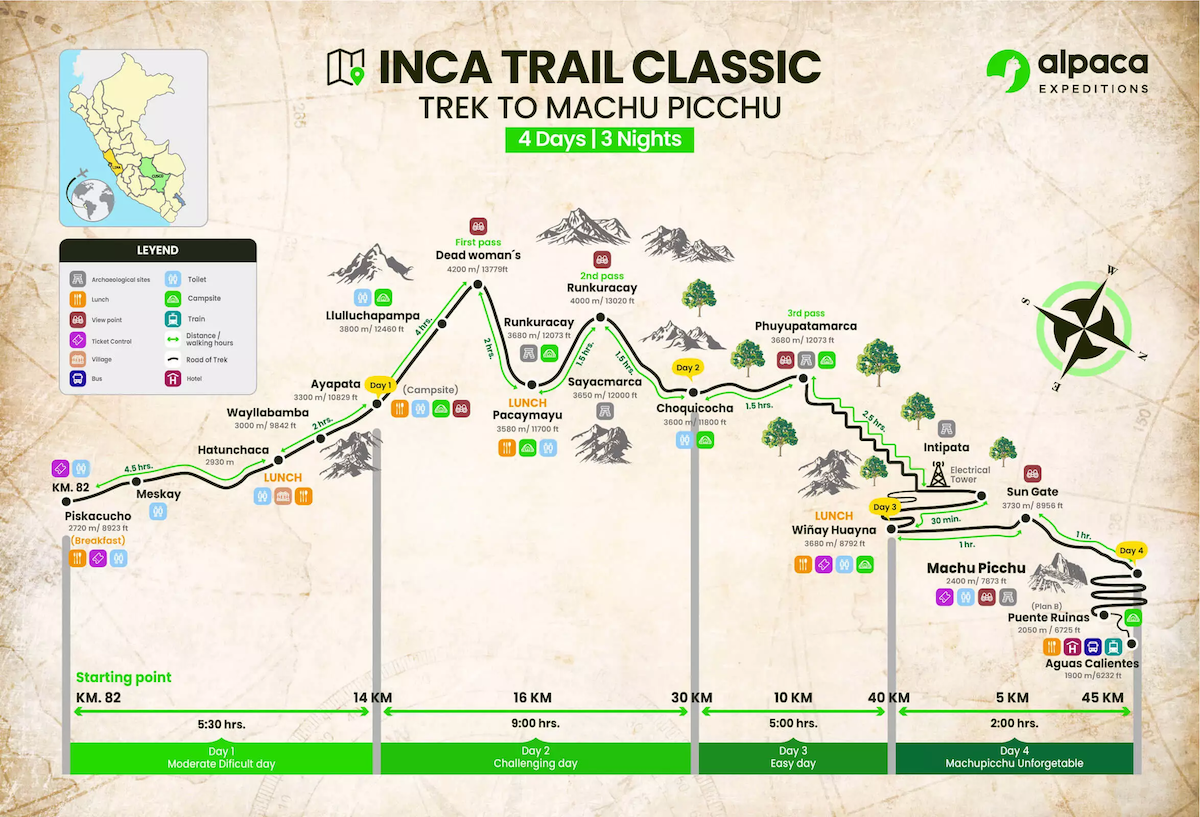
Inca Trail Hiking Tips
1. The best tip we had, which was drilled into us by our wonderful guide, was to take it slow. Finishing the Inca Trail is not a race. Most travellers will only have the opportunity to experience it once and you will not get the record for the fastest time (it’s currently 3 hours 23 minutes by a porter).
At this kind of altitude, taking it slow will keep you at a steady pace and prevent you from over-exerting yourself. If you try to hike it rapidly up steps, you’ll find yourself out of breath and dizzy pretty darn quickly. Not to mention that a slow pace let’s you enjoy your surroundings.
2. Next up, bring rain gear. You do not want to get soaked on this trail. Once you’re wet, it’s tough to dry off in the mountains and you’ll be damp probably for the rest of the hike. If you get wet, you’ll also get cold. Throw fashion out the window and embrace the rain poncho, rain coat and rain trousers. Yes, waterproof trousers as well!
3. If you’re struggling, tell a guide. You’ll have two guides — one at the back and one at the front (roughly). They’re very experienced and have supported hundreds if not thousands of people to complete the Inca Trail, all with varying challenges and ailments. They’re there to help and they have a few tricks up their sleeve too, including agua de florida.
4. If you’re not struggling, don’t be a d%&! If you’re one of the faster hikers in the group, be supportive to others and certainly don’t complain that they’re slowing you down. Part of the experience of hiking the Inca Trail is being part of a group. You’ll be sleeping in tents next to each other, eating meals together and walking together. The trail attracts many people from different walks of life and the best experiences come from being with nice people too.
Arriving at Machu Picchu from the Inca Trail
The grand finale! As the clouds part way (hopefully) to reveal the magical Incan ruins of Machu Picchu that you’ve hiked all this way for, you’re going to feel the biggest sense of satisfaction ever.
You’ll hike down from the sun gate (worth knowing that 90% of the time this is in cloud and there’s no sun at the sun gate, accordingly to our guide) to Machu Picchu. There’s a short hike down with either spectacular views or views of mostly cloud. Most likely you’ll arrive around 7AM to a fairly uncrowded Machu Picchu. The first wave of the tourist hoards will be starting to arrive at a similar time. You won’t have Machu Picchu ‘all to yourself’ but you will still be there early.
There is also a separate viewing platform which is only for Inca Trail hikers to get the classic view (and pics) of Machu Picchu. Plenty of other hikers will be on the same viewing platform, especially during high season, but we had an epic view.
It’s often cloudy at Machu Picchu. When you arrive, you’ll likely have to throw your poles down and take a seat on the grass to wait for the clouds to clear. They usually do.
How Much Time Will You Have at Machu Picchu?
Your Inca Trail tour includes the ticket entry to Machu Picchu and you’ll spend a good few hours walking around the site. Your Inca Trail tour guide will be your Machu Picchu guide too. We arrived at Machu Picchu at around 7AM and left at around 12:30PM. This included time at the photo spot, the tour, some rest breaks and bathroom/coffee runs (much needed after 4 days hiking!) This was plenty of time. We felt we’d seen and experienced everything we wanted to by the time our group was ready to leave.
If you want to do some ‘extras’ such as one of the two hikes inside Machu Picchu (Huchuy Picchu and Machu Picchu mountain), book an overnight stay in Aguas Calientes and return the next day for the hike. Both because you’ll be tired and it’s too much to cram into one day!
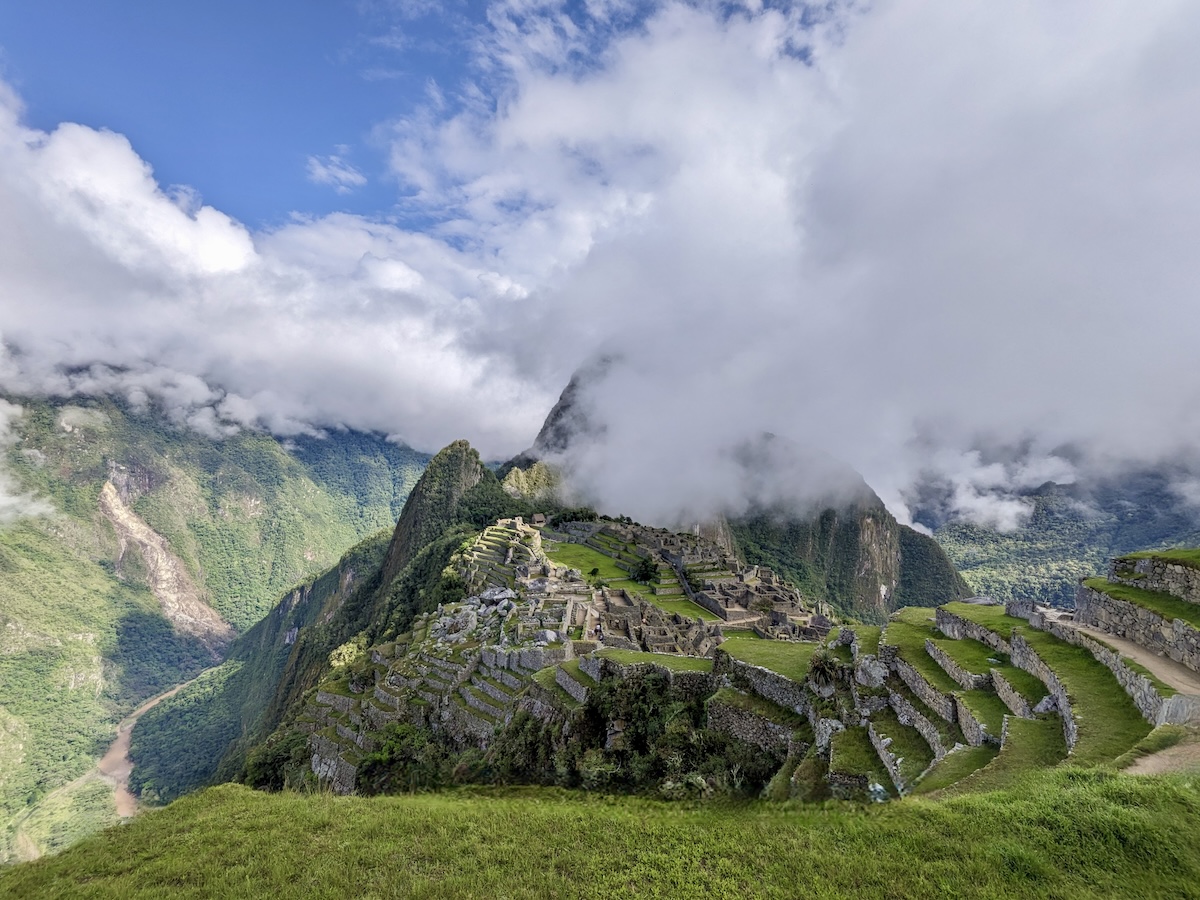
Facilities and Campsites on the Inca Trail
What Are the Campsites like on the Inca Trail?
The campsites are fairly basic spots in the mountains with a toilet and shower block. There are multiple pitches at every campsite. Each tour company usually has a specific area where they set up camp. In most cases, you won’t actually spend much time at the campsites as you’ll usually arrive in the late afternoon and leave early in the morning. The exception is if your tour company does a shorter day 2, in which case you might have almost half a day at the second day’s campsite.
Porters arrive at the campsites much earlier than us hikers and set up the tents. There’s nothing required of you other than to collapse in your tent once you get there!
What’s the Toilet and Shower Situation?
There’s no other way to say this: the campsites and facilities on the Inca Trail are basic. There is only cold water showers and the toilets get progressively worse along the trail. You’ll need to be okay with either no shower or freezing cold shower for the 4 days, au fait with squat toilets and not afraid to pee in the dark as not all toilet blocks have good lighting.
There was an ‘acceptable’ shower block at the campsite on the third night where some of our group braved the cold water. This is, for most, the only viable time to consider a shower. You’ll only often reach the campsites in the early evening when it feels too cold outside to consider a cold shower.
I have to admit, prior to the hike I curled my toes at the idea of no shower for this many days. But, Luke and I didn’t smell half as bad as we thought we would.

Snacks and Food on the Inca Trail
Group Meals on the Inca Trail
You are going to be fed like a king on the Inca Trail trek! Your tour includes a chef and a sous-chef who whip up absolute wonders in a tent with a small camping stove. You’ll have breakfast, lunch and dinner included and these are multi-course affairs with a feast of different plates. We found the amount of vegetables plentiful, the meals generally to be very healthy (though there are some deep-fried options) and with protein at every meal (including for vegetarians like us).
The porters set up a tent for the hikers and guides for the group meals. You’ll by served at a long table. On top the your three meals, there’s also tea around 5PM which consists of hot drinks and a snack like popcorn or toasted marshmallows.
The chefs cater for various different dietary requirements, including vegetarian, vegan and gluten-free. Make sure you let your tour company know any dietary restrictions or allergies in advance, as the food for the trip is all packed in advance and not changeable whilst on the trail.
Snacks on the Inca Trail
You’ll want a hiking snack or two each day on the trail. The tour company usually provide a piece of fruit or biscuits (these may be orange cream or other such strange flavours). Most hikers tend to bring a few of their own cereal bars. It’s a good idea if you’re a bit picky or want a protein-based snack.
On the first day of hiking, there are quite a few vendors selling snacks along the trail. As you might expect, these get progressively more expensive the further along the trail you get as it becomes more rural. You’ll be able to buy chocolate bars, crisps, ice cream, trail mix, biscuits and similar. After the first day, there are no vendors and no opportunity to purchase anything until you arrive at Aguas Calientes on day four.
Drinking Water on the Inca Trail
Peru’s water is not safe to drink. During the Inca Trail, your porters and chefs will filter and boil water for you so that it is safe to drink at each lunch stop and campsite. You’ll refill your water bottle each breakfast, lunch and dinnertime. You need to carry enough water in between mealtimes as after the first day there won’t be any places to buy bottled water.
How Much Money to Bring on the Inca Trail?
There are no card machines up in the mountains. You’ll need enough dough to see you through until you reach Aguas Calientes on the fourth day. We recommend bringing 400-500 soles per person. This should cover enough to buy any additional snacks and drinks on the first day and cover tipping.
Tipping Guides, Chefs and Porters on the Inca Trail
Tipping is standard practice in Peru. You will be invited to tip guides, porters and chefs at the final campsite on the third night. You need to bring cash for the tips. The only ATMs are in Aguas Calientes which you’ll reach at the very end after the porters and chefs have departed.
Whilst tipping is optional, the guides, porters and chefs work extremely hard and most likely you will want to tip. The work is tough and many of the team travel for significant distances (up to 5 hours away from Cusco) to work.
The recommended amount to tip from the whole group is 60-80 soles per porter, 80-100 soles each for the chef and sous chef, and 160-200 soles per guides. Most groups have 12-16 hikers, so expect to contribute a tip of roughly 100-200 soles.
Health and Altitude Sickness on the Inca Trail
Altitude Sickness on the Inca Trail
Altitude sickness whilst on the Inca Trail is common and this will make the hike much tougher. It is essential to acclimatise properly before hiking the Inca Trail. Altitude sickness is a real problem for many hikers who fly into Cusco from sea level. You don’t want to be partway through the Inca Trail gasping at an oxygen tank.
It’s recommended to spend at least 2 days in Cusco to acclimatise. We’d recommend more. If you have time in your schedule, we highly, highly recommend spending your first few days in the Sacred Valley. This is lower altitude than Cusco and will make your first couple of days in the region more pleasant. From the Sacred Valley, move up to Cusco for a few days before starting your Inca Trail trek.
What Happens If You Get Sick on the Inca Trail?
It’s not uncommon for people to get a little unwell on the Inca Trail. Most hikers are travellers in a new country, a different climate, adjusting to higher altitudes. You’re in basic camping conditions, getting a bit wet in the rain and feeling tired from hiking.
If you feel unwell, take it easy. The hike isn’t a race and the guides make sure hikers have plenty of time to complete the hiking days. They assess the group on the first day and adjust the start times for each day based on the hiking abilities of the group. If someone is a bit unwell and a little slower, they’ll suggest the group wakes up earlier. This is to make sure everyone in the group finishes by sunset.
To lessen your chances of getting sick, make sure you have enough clothes with you that you’ll have dry clothes to warm up in at the end of the days. Bring plenty of layers to keep you warm and good rain gear to stop you from getting wet. Wash your hands thoroughly and/or use hand sanitiser before eating. Avoid drinking alcohol (the tours won’t offer you any, so this will only be if you brought it along). Also avoid sharing drinks with other hikers.
It’s worth knowing that you need to bring your own toilet roll for the trail too. Make sure to bring enough (about one good-sized roll per person). We’d recommended bringing wet wipes and hand sanitiser too. There’s no soap and only cold water, and you’ll want to keep your hands clean.
What Happens If You Get Really Sick or Injured on the Inca Trail?
The first answer is, try your best not to! It happens though, of course. We asked our guides about what happens when someone can’t continue on the hike.
Inca Trail guides are prepared for emergency situations. The guides are all trained and qualified in first aid. All guides carry a first aid kit and emergency oxygen in case a hiker has difficulty breathing due to altitude sickness.
The guides and porters do their best to make sure anyone who safely can finish the hike, does finish. This includes guides walking side-by-side with someone from the crack of dawn to way past sunset if needed.
If someone is too unwell, injured or there’s a medical emergency, most of the time the only way out is to either go back or go forward. The Inca Trail is remote and in the mountains, so there are no roads, no vehicle access and nowhere to land helicopters.
If something happens on the first two days of the hike, it’s quickest to go back the way you came. If it happens after, it means going towards Aguas Calientes. How? Porters will carry you. In these cases, porters will take turns to carry you. They continue straight through until they reach the nearest point of transport. The porters are incredibly strong and fit from carrying packs of 25kg along the trail at speed. It means they can be quick to evacuate people when needed. Porters charge an extra fee for their work in these situations.
Our guides had dealt with twisted and broken ankles, various levels of sickness (and unfitness), pneumonia and even a heart attack whilst on the trail. They were remarkably calm about it and had procedures in place for every eventuality.
